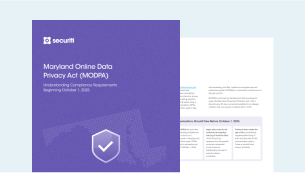What happens when your private-use arms fall into the wrong hands? Of course, it would critically put you and your family in danger. Now, take the scenario to a macro level and assume what would happen if a country’s military secrets got into the wrong hands. It will put the entire country and all its residents in serious harm's way. This is something truly unimaginable.
The US government has established the International Traffic in Arms Regulations (ITAR) to prevent such a chaotic event from happening.
Today, ITAR compliance presents a series of challenges to organizations. For starters, many mistakenly assume that ITAR regulates every type of military article, weapon, software, or technical documentation. On the other hand, some find it increasingly challenging to control and manage ITAR data for continuous compliance.
If your organization finds itself in the same boat, check out the ITAR compliance checklist we’ve compiled to help you ease your concerns and meet compliance.
A Quick Overview of ITAR Compliance
The ITAR is implemented and enforced by the Directorate of Defense Trade Controls (DDTC) of the Bureau of Political-Military Affairs within the U.S. Department of State. ITAR regulates all manufacturers, distributors, exporters, importers, and brokers who manufacture, sell, distribute, export, or temporarily import defense-related government and military goods. The defense-related articles include military gear, weaponry, equipment, instruments, software, and technical documentation that are covered on the United States Munitions List (USML).
By technical documentation, ITAR implies all such blueprints, flow-chart, patented data, and schematics used for manufacturing, upgradation, maintaining, or modifying ITAR-covered articles on the USML.
It is also crucial to understand that ITAR compliance even includes supply chain services in distributing ITAR-covered defense goods and services. Regardless, it is crucial for manufacturers and other ITAR-covered entities to understand and implement the principles of ITAR compliance thoroughly. After all, the penalty for non-compliance can range from a heavy fine of up to $1,000,000, criminal prosecution of up to 20 years, or both.
Learn more about ITAR, responsibilities of the controllers, the data types it covers, and the challenges organizations face with compliance governance.
ITAR Compliance Checklist
The following ITAR compliance checklist includes all the important requirements that ITAR-covered entities must fulfill to comply with the regulation.
1. Determine the Legal Authority over Your Product
ITAR compliance applies to only those military goods, services, technical data, and software that are covered by the USML. If the articles are USML-covered, then the US Department of State has jurisdiction over the organization or entity, and ITAR will be applicable.
However, if an organization or an entity (manufacturer, dealer, distributor, or wholesaler) deals in defense articles that are not covered in the USML, then the entity may fall under a different regulation, such as the Export Administration Regulations (EAR), which is administered by the U.S. Department of Commerce's Bureau of Industry and Security (BIS). EAR governs commercial or dual-use items' manufacturing, selling, distribution, and export. A dual-use item may have both civil and military purposes. Take, for instance, a cellular device with an encryption application. The cellular device may serve a domestic purpose, but the encryption application could be used for military purposes.
The next most important step is to go through the articles of ITAR, which consist of 11 parts. This will allow an entity to understand the requirements better and align its privacy practices with the regulation. It should also be noted that the regulations are kept vague and open to interpretation. This vagueness benefits both the government and a business dealing in ITAR-related items or data. The government can leverage the flexibility in the regulation to respond to evolving technologies and national security threats. On the other hand, businesses can tailor their compliance program according to their risk profile or specific conditions.
3. Complete Registration with the Directorate of Defense Trade Control
The ITAR-covered entities must complete their registration with the Directorate of Defense Trade Control (DDTC) by submitting a Statement of Registration. The statement includes the details regarding the registrant, such as their name, contact address, and the USML-covered military goods, services, software, or technical documents they handle. The registration is subject to renewal every 12 months.
Furthermore, at the time of registration, a senior officer of the registrant is required by the DDTC to certify that no business member has been subject to any criminal prosecution or banned from contracting or receiving a license for the export or import of USML-covered military items. Lastly, if the registrant is a foreign person, i.e., someone who is not well-protected by the US government, their contact details and ownership must also be included in the Statement of Registration.
4. Categorize Your USML-Covered Item
The USML is regulated by the Arms Export Control Act (AECA), which enables the US President to designate goods and services that could be considered defense-related. The USML is broadly categorized into 21 categories, which are further classified into 16 sections.
Classification of the ITAR-covered item according to USML categories is imperative for the ITAR-covered entities because it determines the exporting restrictions, exemptions, and licensing requirements of those items. It also helps the entities determine whether they must obtain any license or approval before exporting the items.
5. Check the End-Use of the Item and the End User
As mentioned earlier, the primary purpose of ITAR compliance is to ensure that defense-related items do not fall into the wrong hands, posing serious national security risks. Therefore, ITAR has also made it necessary for ITAR-covered businesses to determine the item's end-use and end user.
The “end-use” is the final purpose of the item it would serve, while the end user is the business or an individual using the item. The ITAR-covered entities are also required to conduct due diligence that the recipient of the item is authorized to receive the defense-related goods as per US laws. The businesses must further ensure that the item will not be re-exported without any approval from the DDTC.
6. Apply for an Export or Temporary Import License
An ITAR-covered entity that intends to export or temporarily import defense-related articles or services must obtain a license from the DDTC unless the export or temporary import qualifies for an exemption under the provisions of ITAR. The export license must provide all the necessary details regarding the transfer and the items, such as the details of the recipient of the item, the end-use and end-user of the item, and the recipient country. Under ITAR, the licenses are valid for up to 4 years.
7. Maintain Comprehensive Records of All Activities
As a necessary part of the compliance framework, it is essential for registrants to keep a comprehensive record of all ITAR-related activities. The registrant must keep a record of all the registration details of the registrant, the export or temporary import licenses, the military item that is subject to export or import, the end-use of the item, and the end user. All such relevant records must be maintained in a timely manner for audit purposes for at least 5 years.
8. Implement an Internal Compliance Program
As mentioned earlier, the vagueness of the ITAR provisions gives businesses the leverage to customize their compliance program as per their business circumstances and risk profile. The compliance program must always be clearly documented, tailored to the registrant business, and must be reviewed periodically. An effective internal compliance program also allows entities to fulfill their reporting obligations under ITAR, i.e., notifying DDTC of violations or non-compliance.
Meet ITAR Compliance Every Step of the Way with Securiti Data Command Center
Securiti Data Command Center gives sensitive data insights across your business data landscape, enabling you to streamline your ITAR compliance and governance functions. Get a complete inventory of your sensitive ITAR data, who are accessing that data, what ITAR regulations and cross-border data transfer regulations apply to it, and how you can automate compliance.
With Securiti Data Command Center, you can reduce operational expenses, data inconsistencies, and non-compliance risks.











































